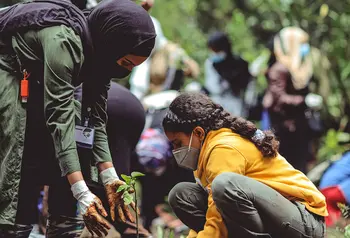A practical guide to more inclusive hiring

The Racial equity in nature toolkit is aimed at organisations in the natural heritage sector to help them attract more diverse candidates through inclusive recruitment.
It has a focus on recruiting those at the beginning of their careers, in particular people aged 18-25 from ethnically diverse communities.
A fairer and more sustainable future, for everyone
Diversity and inclusion are central to tackling the climate and biodiversity emergencies.
It’s important we have a diverse range of voices involved in this great challenge, and represented in the environment sector workforce, in order to create a fairer and more sustainable future, for everyone.
In order to inspire and train more young people from diverse backgrounds to take part, we need to actively work to address the barriers they face.
However, as the second least-diverse sector in the UK – only 3.1% of the environmental sector workforce is from minority ethnic backgrounds – a lot of work needs to be done to make nature a more inclusive space.
In order to inspire and train more young people from diverse backgrounds to take part, we need to actively work to address the barriers they face in accessing the sector.
Kick-starting your EDI journey
The events of the past couple of years have made many people think more about equality, diversity and inclusion (EDI).
The coronavirus (COVID-19) pandemic has made many socio-economic inequalities worse, particularly for young people from ethnically diverse communities, as this Generation Covid research shows.
The Black Lives Matter movement has also galvanised many to reflect on whether they are doing enough to address discrimination and racism. That’s one of the reasons why we launched our EDI review, as part of our commitment to drive greater – and quicker – change within our organisation and across the heritage sector.
We recognise that many organisations are also wanting to do more in relation to EDI in the workplace but don’t know where to start.
With this in mind, this guide is designed to give hiring managers the tools and confidence to kick-start their EDI journey, with a particular focus on recruitment.
What the toolkit involves
Inside the toolkit you will find practical tips and advice, along the key themes:
- advertising and outreach
- writing job descriptions
- shortlisting candidates
- selecting candidates and support for staff
There is also lots more on reducing unconscious bias, and how to be a better ally.
We all have a part to play in championing greater diversity and inclusion in the workplace, so the tips and guidance in this toolkit could also work for any heritage organisation, of any type or size.
What we have learnt
Collaboration is a key driver of change.
There’s already so much great work being done by landscape and nature organisations to break down barriers to nature and diversify their workforce and volunteers. A lot of this has been achieved by working with others.
The process of listening, learning and embracing different perspectives has also been essential to creating this guide.
What we hope to achieve
We hope this toolkit will empower organisations with the knowledge and tools to begin to improve access to the heritage sector for young people from diverse backgrounds.
Through more inclusive recruitment practices and beginning to challenge our own internal biases, we can all create a working environment that welcomes a real diversity of thought.
Find out more
You can also find out more about the Heritage Fund's own EDI Review report and the work we are doing to improve our own EDI.
We also expect every project we fund to meet our mandatory outcome that "a wider range of people will be involved in heritage".


